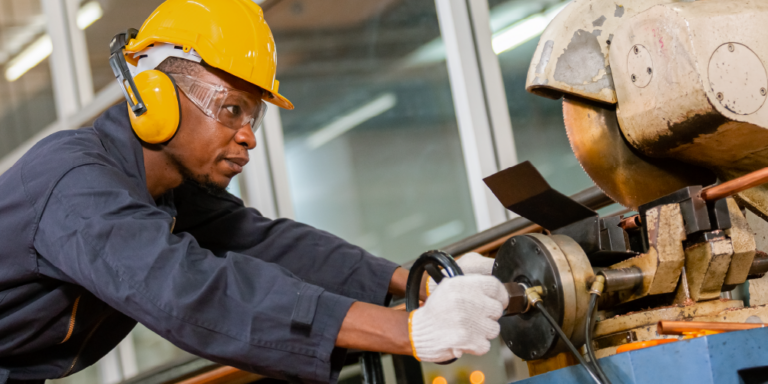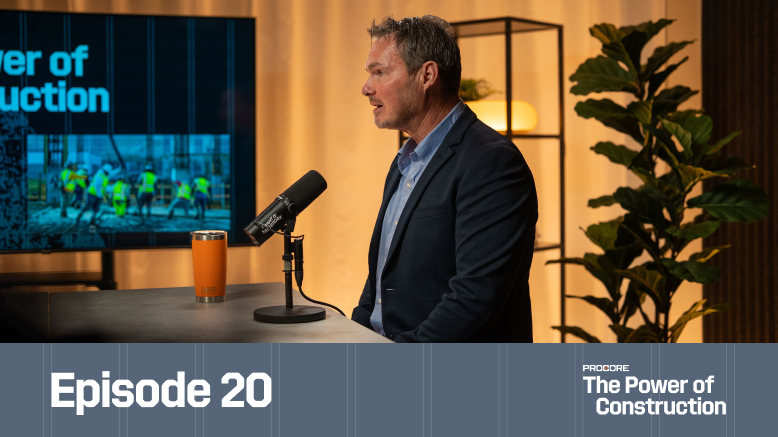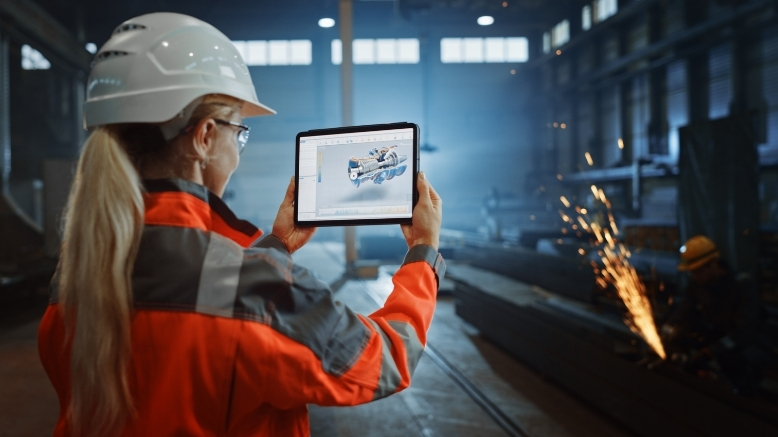— 12 min read
Construction Noise: How to Reduce Noise Pollution & Protect Workers


Last Updated Sep 29, 2025

Jacob Kunken
Solutions Engineer, Heavy Civil
28 articles
Jake Kunken currently works as Solutions Engineer for Procore's Heavy Civil division. He brings 14 years of experience working in various construction roles in New York and Colorado, including laborer, assistant carpenter, carpenter, assistant superintendent, superintendent, construction manager, safety manager, and project manager. Jake also spent time in EHS as an environmental engineer for Skanska. He’s worked on more than 40 commercial projects from ground-up, to heavy civil, hospital work, and tenant improvement. Jake studied Ecological Technology Design at the University of Maryland.

Bob Hanes
Founder
15 articles
Bob Hanes is a professional writer and entrepreneur. He previously worked as a military sales and applications engineer for an aerospace firm, and cofounded a biotech company that creates drug screening solutions for the pharmaceutical industry. Bob has an MBA from the University of Buffalo in Logistics, Materials, and Supply Chain Management, and a BE in Mechanical Engineering. He is an avid Buffalo Bills fan.
Last Updated Sep 29, 2025

Construction is an inherently noisy activity, which can significantly impact both the workers involved and the broader environment. The noise of power tools, heavy machinery, site demolition and more can contribute to both immediate and long-term health risks for construction workers — including hearing loss, stress and lowered productivity.
Noise pollution doesn't just stop at the borders of the construction site — it can also reverberate into surrounding neighborhoods, disrupting peace and quiet and impacting quality of life. In light of these issues, construction firms and contractors bear the dual responsibility of safeguarding their workforce's health and minimizing their operations' disruptive impact on the community.
In this article, we’ll dive into the types of construction noise, what causes it, who it impacts, rules and regulations of construction noise and how it can be reduced.
Table of contents
What is noise pollution?
Noise pollution is the name for any unwanted or harmful sounds that can disrupt the environment and negatively affect people and wildlife in the surrounding area.
On construction sites, noise pollution comes from construction machinery and tools and worker activities involving hammering, drilling or transporting materials around the site.
Types of noise in construction
Continuous noise
Continuous noise in construction persists for an extended period of time. Unlike impulsive noise, which comes in bursts, continuous noise is steady and unvarying, similar to a drone or a hum that stays constant over time. Machinery or processes that operate without interruption often produce this noise.
Some examples of continuous noise in construction include the humming of generators, the constant whir of an operating excavator, the steady drone of ventilation systems, or the ongoing rumble of cement mixers. This persistent background noise exposure can be harmful to workers over a long period of time.
Impulsive noise
Impulsive noise is characterized by sudden, loud bursts of sound that are often of high intensity but short duration. These noises are typically more jarring and noticeable than continuous noise due to their abrupt and disruptive nature. Impulsive noise adds to the overall noise level at a construction site, and its spread can significantly impact people at varying distances.
In construction settings, impulsive noise can come from a variety of sources. The loud bang of a pile driver pounding into the ground, the explosive bursts from powder-actuated tools, or the pounding of jackhammers are all examples of impulsive noise.
Noise levels of common construction activities
Understanding the noise levels produced by different construction activities is vital to managing and mitigating their potential impact. Noise levels are usually measured in decibels (dB) using a decibel meter or noise dosimeter, and rates sound using a logarithmic scale to quantify its power or intensity.
These meters provide immediate readings, allowing for immediate adjustments if the sound levels exceed safety guidelines.
A noise dosimeter is a small device that a worker can wear during their shift to measure their total noise exposure over time. This is particularly useful for workers who move around the site with varying different noise levels.
Before being used onsite to take measurements, safety managers calibrate these devices in a quiet room or office. A safety manager may take multiple readings at different times throughout the day, marking down the location and time of each reading. These measurements, when charted over time, give a clear picture of how much noise a construction site generates at varying distances and times.
Construction equipment
- Jackhammers: Jackhammers, used typically for breaking concrete, can produce noise levels of around 120-130 dB.
- Pile Driving: Pile driving involves hammering large cylindrical poles into the ground, which can result in noise levels of approximately 110-120 dB.
- Bulldozers: These heavy-duty vehicles used for moving dirt and debris can produce noise levels around 100-110 dB.
- Cement Mixers: Cement mixers, which constantly churn to keep cement at the right consistency, generate continuous noise levels of around 85-90 dB.
- Generators: These essential pieces of equipment that provide power to the site typically produce continuous noise levels of about 80-90 dB.
It's important to note that prolonged exposure to noise levels above 85 dB can cause permanent hearing damage. Knowing the noise levels of various construction activities helps in planning appropriate preventive and protective measures for workers and mitigating the impact on the surrounding environment.
Construction noise rules & regulations
The mitigation of construction noise is not just a matter of courtesy or good practice. Various federal and local laws also regulate it to ensure the health and well-being of workers and the community.
The Occupational Health and Safety Administration (OSHA) sets standards for noise exposure, known as permissible exposure limits (PEL) in the workplace. OSHA's permissible exposure limit for construction noise is an average of 90 decibels over an 8-hour day.
Below is a table detailing the PELs depending on the sound level and length of time:
| Duration per day (hours) | Sound level dBA slow response |
|---|---|
| 8 | 90 |
| 6 | 92 |
| 4 | 95 |
| 3 | 97 |
| 2 | 100 |
| 1½ | 102 |
| 1 | 105 |
| ½ | 110 |
| ¼ or less | 115 |
Failure to adhere to these standards can result in hefty penalties. OSHA can impose fines, and repeated or willful violations can lead to larger fines or even criminal charges.
OSHA conducts regular inspections to ensure compliance with their standards. During these inspections, OSHA may measure noise levels and assess safety practices.
OSHA's 2-to-3 Foot Rule
OSHA also provides a guideline for situations when a sound level meter isn't available. The 2-to-3 foot rule implies that the noise level is assumed to be at, or above, 85 decibels if a worker must raise their voice to be heard when standing two to three feet away from a coworker.
This level is significant, as it represents the threshold at which sustained exposure can result in hearing damage. The 2-to-3 foot rule serves as a quick and easy method to assess noise levels and determine if additional measures need to be taken to protect workers' hearing.
Local Ordinances
In addition to federal regulations, many municipalities have their own rules around environmental noise. These can include restrictions on the times of day when loud work occurs, as well as limits on acceptable noise levels.
For example, in New York City, construction sites have to apply for an after-hours authorization for any work performed outside of weekdays between 7 a.m. and 6 p.m. The specifics of these ordinances can vary widely, so it's important for construction companies to familiarize themselves with the regulations in each area where they operate.
Importance of Adherence and Additional Precautions
While compliance with these regulations is essential, they should be considered the minimum standard.
Construction companies have a responsibility to their workers and the community to go beyond these minimum requirements whenever possible. This can include providing additional protective equipment, implementing more stringent noise monitoring practices, or adopting quieter construction methods. Such proactive measures can help to further reduce the impact of construction noise on workers and the surrounding community.
The Impact of Construction Noise
The repercussions of construction noise are extensive and encompass both the workers and the surrounding environment. Construction firms should strive to understand how noise can affect these parties. OSHA covers the three largest areas that noise can impact workers, which are physical and mental health and lower productivity.
Physical health
Continuous exposure to high noise levels can lead to noise-induced hearing loss, a common occupational disease in the construction industry. According to the U.S. National Institute for Occupational Health and Safety (NIOSH), about 25% of noise-exposed construction workers tested for it have a material hearing impairment (hearing loss that impacts day-to-day activities). This type of hearing loss can be temporary or permanent, and it often progresses so gradually that workers may not notice until substantial hearing loss has occurred. Additionally, NIOSH reports that 7% of all construction workers experience tinnitus.
Mental health
Besides the physical effects, constant noise can also have psychological impacts. High noise levels can lead to increased stress, irritability and fatigue, potentially contributing to other mental health disorders such as anxiety and depression.
Additionally, the consequences of hearing loss caused by noise exposure on the job can be serious for mental health.
“Hearing loss can greatly impact a worker’s overall health and well-being,” says NIOSH Director Dr. John Howard. “Hazardous levels of occupational noise exposure and environmental noise exposure both need to be avoided.”
Lower productivity
The detrimental effects of noise on physical and mental health can significantly reduce a worker's productivity. Struggling to communicate over loud noise can lead to misunderstandings and mistakes, and the fatigue from constant noise exposure can slow down the pace of work.
Environmental impact
Construction noise can disrupt the peace of residential neighborhoods, affecting the quality of life for residents. This disruption can lead to complaints and strained relationships between the construction project and the community.
Noise and vibration often go hand in hand in construction sites. Vibrations caused by heavy machinery and construction processes can cause damage to nearby structures, affect structural integrity and can also disturb wildlife in and around the construction site.
The case of the "Leaning Tower of Fidi" underscores the importance of careful monitoring. Despite the project topping out in September 2018, controversies, delays and construction issues have plagued it. The most notable of these problems is that the building leans 3 inches to the north, reportedly due to the method used for foundation construction. The general contractor, Pizzarotti, blamed the building's developer, Fortis, for this issue, alleging that they used a soil improvement method instead of the more stable piling method used in neighboring skyscrapers.
The legal dispute between the two companies, coupled with a series of building code violations and safety incidents, brought construction to a standstill.
By 2023, only half of the finishes, including windows, have been installed and the site remains secured and inactive. The halted project, with its noticeable lean, is a stark reminder of the challenges and risks associated with high-rise construction in the bustling heart of New York City.
This highlights the necessity of robust noise and vibration monitoring and mitigation strategies on construction sites.
Construction noise and vibration must be monitored closely to avoid causing disturbances or structural damage. This involves setting data points on adjacent structures and checking regularly for any movement or change. Monitoring becomes crucial in urban settings where construction sites are surrounded by other buildings and structures, as highlighted by the construction practices in Manhattan.
How to reduce noise pollution on the jobsite
Mitigation of construction noise is not just a legal obligation, but it also forms part of the corporate social responsibility of construction companies. Let's look at some strategies to reduce and control noise at construction sites.
In dealing with construction noise, both engineering and administrative controls play significant roles. Engineering controls focus on reducing the noise at the source or along the noise path, while administrative controls manage workers' exposure to noise.
An example of an engineering control would be replacing an outdated piece of equipment with a newer, quieter version. Meanwhile, an administrative control would be running a noisy piece of equipment when a majority of site workers are on lunch break.
7 strategies to mitigate construction noise
1. Monitor jobsite noise levels.
Regular monitoring of jobsite noise levels can help identify areas or activities that contribute to high noise levels and then implement targeted noise control strategies.
By keeping a log of noise readings from different types of equipment and distances, construction managers can track patterns and identify areas for noise reduction. Monitoring can also help to ensure that mitigation measures are triggered and implemented as soon as noise levels exceed safe thresholds.
2. Make PPE accessible.
Personal Protective Equipment (PPE) such as earplugs or earmuffs should be readily available to workers to limit their exposure to loud noises.
However, PPE will only be effective if it is readily available and consistently used by workers. By making PPE accessible at every point of need on the jobsite, construction managers can encourage its regular use and cultivate a culture of safety.
3. Encourage visual communication.
High noise levels can hinder verbal communication on the jobsite, which could potentially lead to accidents. In particularly noisy environments, encourage the use of visual signals or signs to communicate, reducing the need for workers to shout.
For instance, workers can use eye contact to gain the attention of equipment operators and hand signals to convey messages. Additionally, site signage such as “noise exposure zone,” “loud machinery in use,” or “hearing protection required” makes visitors aware of the need for proper PPE and alerts them to take the proper precautions when heading into noisy areas.
4. Limit exposure.
Another effective strategy to prevent noise-induced hearing loss is to limit workers' exposure to high noise levels.
Try to rotate workers between high-noise and low-noise tasks throughout the day to limit their exposure to constant loud noise. This could involve scheduling regular downtime or quiet periods during the workday and providing quiet spaces for workers to rest and recuperate.
5. Update and maintain equipment.
Regular maintenance can keep equipment running smoothly and more quietly. Worn-out or faulty parts can create additional noise and may also pose safety risks. Additionally, investing in new, quieter equipment can significantly reduce overall noise levels.
6. Use noise barriers.
Noise barriers or shields block noise from spreading to adjacent areas. By directing jobsite noise upwards, noise pollution can be substantially reduced in neighboring communities. These can be particularly useful in urban construction sites close to residential areas or schools.
7. Train and educate employees.
Educating workers about the risks associated with prolonged noise exposure and training them on the proper use of PPE and other noise reduction strategies is maybe the most important strategy. This will equip them to protect themselves and their coworkers from the harmful effects of noise.
Educational resources, such as OSHA's noise pollution pocket guide, can be useful tools for raising awareness and promoting good practices.
Creating a culture of noise safety
Creating a culture of noise safety goes beyond implementing strategies and controls; it's about shifting mindsets and behaviors toward a sustained commitment to noise reduction and safety. Leadership plays a pivotal role in establishing and maintaining a culture of noise safety. Top management must understand and prioritize noise safety, setting the tone for the rest of the organization: Seeing leadership embody these behaviors can significantly impact the overall organization's attitude toward noise safety.
Leaders can demonstrate their commitment by investing in the necessary equipment and training to mitigate noise hazards. They can also foster open communication about noise hazards, encouraging employees to voice concerns and suggestions without fear of repercussions. By doing so, leaders can create an environment where noise safety is viewed as a shared responsibility.
Was this article helpful?
Thank you for your submission.
100%
0%
You voted that this article was . Was this a mistake? If so, change your vote
Scroll less, learn more about construction.
Subscribe to The Blueprint, Procore’s construction newsletter, to get content from industry experts delivered straight to your inbox.
By clicking this button, you agree to our Privacy Notice and Terms of Service.
Thank you!
You’re signed up to receive The Blueprint newsletter from Procore. You can unsubscribe at any time.
Categories:
Written by

Jacob Kunken
Solutions Engineer, Heavy Civil | Procore Technologies
28 articles
Jake Kunken currently works as Solutions Engineer for Procore's Heavy Civil division. He brings 14 years of experience working in various construction roles in New York and Colorado, including laborer, assistant carpenter, carpenter, assistant superintendent, superintendent, construction manager, safety manager, and project manager. Jake also spent time in EHS as an environmental engineer for Skanska. He’s worked on more than 40 commercial projects from ground-up, to heavy civil, hospital work, and tenant improvement. Jake studied Ecological Technology Design at the University of Maryland.
View profile
Bob Hanes
Founder | Resonant Lab
15 articles
Bob Hanes is a professional writer and entrepreneur. He previously worked as a military sales and applications engineer for an aerospace firm, and cofounded a biotech company that creates drug screening solutions for the pharmaceutical industry. Bob has an MBA from the University of Buffalo in Logistics, Materials, and Supply Chain Management, and a BE in Mechanical Engineering. He is an avid Buffalo Bills fan.
View profileExplore more helpful resources

Why Don’t We Protect the Whole Person?
Behind every safety incident is a person — and behind that person is a story we rarely ask about. Were they already exhausted before they arrived on site? Did they...

What Drives Better Safety Outcomes—Carrot, Stick, or “Zero Harm”?
On paper, construction has never looked safer. In reality, mental health claims are rising, workers are disengaged and the compliance playbook is broken. Garry Mansfield, co-founder of Scratchie, argues the...

How Close Are We to Bridging the Design-Build Divide?
For decades, construction decisions have often been made based on gut instinct. But what if the real barrier to transformation isn’t technology—it’s the divide between design and construction? In episode...

Gain Without Pain: Leveraging Technology for Strategic Safety Programs
In safety, there is always room for improvement, and technology creates the ability to scale safety programs that drive risk mitigation, operational efficiencies and competitive advantage. In fact, builders who...
Free Tools
Calculators
Use our calculators to estimate the cost of construction materials for your next project.
Templates
Find a template to help you with your construction project tasks.
Material Price Tracker
Get the latest U.S. retail prices and view historical trends for common building materials.
Glossary
Explore key terms and phrases used in the industry.
